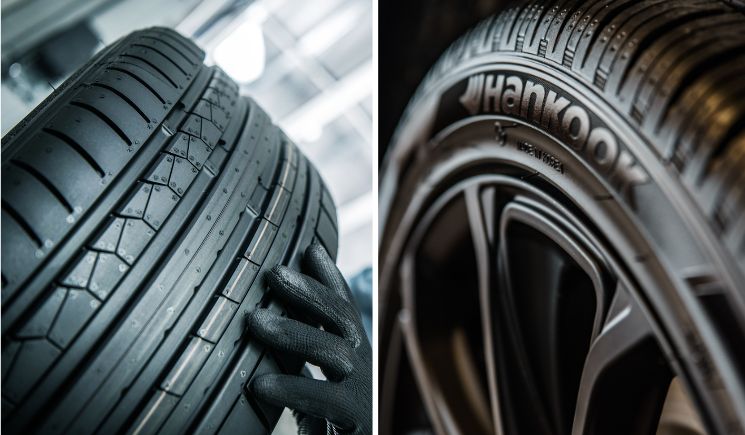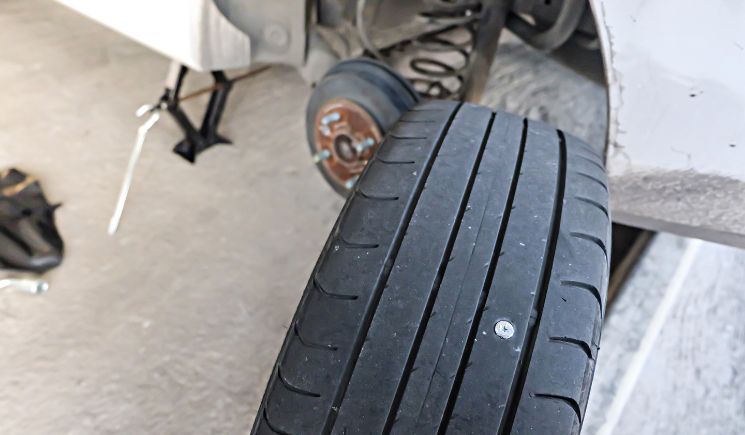Steer Tires Vs Drive Tires

When it comes to automotive tires, there are two main types: steer tires and drive tires. But what’s the difference between the two? Steer tires provide greater stability when turning while drive tires offer superior traction on straightaways. As an automotive tire expert, I can tell you that understanding the differences between these two types of tires is essential for getting maximum performance from your vehicle.
In this article, we’ll take a detailed look at both steer and drive tires, exploring their unique features and applications in order to gain a better understanding of how they function together as part of an effective tire system. We’ll discuss design components such as tread patterns, construction materials and load ratings so that you have the information necessary to make informed decisions about which type of tire will best meet your needs.
Table of Contents
- Overview Of Steer Tires
- Overview Of Drive Tires
- Differences In Size And Tread Patterns
- Differences In Performance
- Differences In Cost
- Selecting The Right Tires For Your Truck
- Frequently Asked Questions
- Conclusion
Table: Overview of Steer Tires and Drive Tires
| Attributes | Steer Tires | Drive Tires |
|---|---|---|
| Purpose | Provide stability and control during steering | Provide traction during acceleration and braking |
| Width | Wider (due to increased contact patch area) | Less wide |
| Tread Pattern | Unique patterns, stiffer sidewalls, fewer grooves | Symmetrical design, optimized for grip & durability |
| Load Capacity | Higher load capacity, faster wear rate | Lower load capacity, longer lifespan |
| Performance | Better steering control, better cornering stability | Greater traction, improved braking, better fuel efficiency |
| Size Difference | Up to 4 inches larger in diameter | – |
| Tread Depth | Shallower tread depth | Deeper tread depth |
| Cost | Generally more expensive | Generally less expensive |
| Selection Considerations | Stability, handling, durability | Traction, durability, fuel efficiency |
Overview Of Steer Tires
Do you ever think about the differences between steer tires and drive tires? As an automotive tire expert, I can say that there are quite a few. Steer tires provide stability to the front end of your vehicle while navigating corners or while driving in bad weather conditions. Let’s take a closer look at what makes these tires unique.
Steer tires tend to be wider than their drive counterparts because they need additional surface area for better grip on the road when cornering or under wet conditions. When steering, this extra width helps with traction so the car is more stable as it moves from left to right around turns. The tread design of steer tires also differs from other types of auto tires since it has fewer grooves on its outer edge which allows for increased contact with the road’s surface during tight turns.
These specific qualities make steer tires well-suited for vehicles that spend more time turning than going straight ahead – such as cars and trucks used for racing purposes – but may not perform as well in dry conditions compared to conventional street use models due to their lack of wide open grooves on the outside edges. With all this in mind, let’s move onto our next topic: overview of drive tires….
Overview Of Drive Tires
When it comes to the wheels of a car, steer tires and drive tires are two essential components. Both types of tire share some similarities in terms of construction, but there are also some key differences that must be considered when selecting the right set for your vehicle.
Steer tires have an increased contact patch area compared to drive tires since they take on more weight due to their role as front-wheel drivers. This makes them slightly wider than their rear counterparts and they often feature unique tread patterns with stiffer sidewalls that help provide better steering control at higher speeds. Additionally, steer tires tend to wear down quicker than drive tires due to their extra load capacity.
Drive tires typically feature a symmetrical design that helps provide greater traction during acceleration and braking. As these are usually mounted on the rear axle, they don’t need as much width or stiffness as steer tires; however, their tread pattern is designed for grip and durability over long distances so they can last longer under normal driving conditions.
Overall, both types of tire play important roles within a vehicle’s wheel system and understanding the subtle nuances between each type will ensure you get the most out of your investment:
- Steer Tires: Increased contact patch area/Unique tread patterns & stiffer sidewalls/Higher load capacity & faster wear rate
- Drive Tires: Symmetrical design/Less width & stiffness needed/Tread pattern optimized for grip & durability
It’s clear that careful consideration should go into choosing the best options for your specific needs – especially when differentiating between steer and drive tires based on size and tread patterns.
Differences In Size And Tread Patterns
When it comes to tires, the differences between steer and drive tires are vast. While they may appear similar at first glance, there is much more than meets the eye when comparing these two distinct types of rubber. Did you know that the average size difference between a steer tire and its corresponding drive tire can be as much as four inches in diameter? This means that even though both serve an essential purpose for vehicles, their sizes must be carefully considered during installation.
The tread patterns on steer and drive tires also differ significantly. Steer tires have a shallower tread depth compared to those found on drive tires, which need extra grip to handle heavier loads or terrain changes. Additionally, steer tires often feature different sipes along the middle rib of each tire. These small cuts help improve traction around turns by providing additional surface area for gripping onto the road’s surface.
It’s clear that although both types of automotive tires play a vital role in keeping vehicles safe and secure on the roads, their design elements vary greatly from one another due to specific performance needs required in each application. With this knowledge in mind, let’s examine how these differences impact overall vehicle performance.
Differences In Performance
Steering tires and drive tires differ in performance for a variety of reasons. Steering tires, also known as front-wheel drive (FWD) tires, are designed to provide the driver with maximum control when turning the car. They have wide tread blocks that allow them to grip the road more effectively than other types of tires while providing excellent cornering stability. In addition, they feature stiff sidewalls to minimize flex during cornering and enhance overall handling capabilities.
Drive tires, on the other hand, are built for durability and traction under acceleration. These tires typically feature a deeper tread pattern with improved rubber compounds that increase their lifespan and promote better braking ability on wet roads. Their extra width also helps disperse water from beneath the tire’s contact patch which can help reduce hydroplaning. Additionally, they usually have reinforced sidewalls to reduce rolling resistance and improve fuel efficiency.
The two types of tire may look similar but their unique design makes them perform differently in certain situations. While steering tires offer increased responsiveness during turns at high speeds, drive tires excel at maintaining grip over longer distances or when accelerating quickly from rest. Knowing which type of tire is best suited for your vehicle will ensure you get optimal performance out of it. With this knowledge, drivers can make an informed decision about how to equip their vehicles for various driving conditions. Transitioning into different surfaces or weather patterns can be handled much easier by having both sets of proper tires installed on your vehicle.
Differences In Cost
Steer tires are designed for vehicles that require a high level of maneuverability and control, such as commercial trucks. On the other hand, drive tires are specifically developed to provide better traction on wet or icy surfaces. As a result of their differences in design and purpose, steer tires tend to be more expensive than drive tires.
When it comes to performance, steer tires provide superior handling capabilities due to deep tread grooves which helps disperse water off the road surface quickly. Additionally, they have stiffer sidewalls with reinforced belts for increased longevity under heavy loads. Drive tires also offer improved grip but not at the same level as steer tires. They typically feature an aggressive tread pattern with wide shoulders and sipes that give extra biting edges during cornering and braking maneuvers on rain-slick roads.
The cost difference between steer and drive tires can vary significantly depending on size and brand. Generally speaking though, steer tire prices will usually be higher since they use additional components in their manufacturing process compared to regular passenger car tyres. This is especially true if you require specialized truck tyres like winter tyres or all-terrain varieties. Now that we’ve looked at the performance and cost differences between these two types of tyre, let’s move on to selecting the right ones for your vehicle needs.
Selecting The Right Tires For Your Truck
Tires are the unsung heroes of your truck, much like an orchestra in a symphony. Selecting the right kind of tires is key to ensuring that you have safe and reliable transportation. When it comes to steering tires versus drive tires, there are numerous differences between them that require careful consideration when making a purchase.
Steer tires possess greater stability on highways due to their larger size which allows for better handling during long drives over smooth roads. They also tend to be more expensive than drive tires because they are made with thicker sidewalls for enhanced durability. On the other hand, drive tires have increased traction so they can handle extreme weather conditions such as rain or snow better than steer tires. Additionally, these types of tire typically last longer since they feature wider tread patterns designed for optimal grip on wet surfaces.
It’s important for any driver to evaluate what type of driving conditions will be experienced before selecting the appropriate set of tires for their truck. In most cases, a combination of both steer and drive tires should provide enough stability and control while keeping costs at a reasonable level. Whether you’re looking for extra traction or improved maneuverability, choosing the right type of tire is essential to ensure that your truck remains safe and roadworthy throughout its lifetime.
Frequently Asked Questions
How Often Should I Rotate My Steer And Drive Tires?
The frequency of tire rotation depends on the type, model and condition of your tires. Generally speaking, most manufacturers recommend rotating steer and drive tires every 6 months or 5,000-7,500 miles. It’s important to have proper tire rotation done by a professional mechanic in order for you to get the best out of them over time. Also, check regularly for signs of uneven wear as that can indicate misalignment or other issues that should be addressed promptly.
How Long Should My Steer And Drive Tires Last?
Tire longevity is an important factor when it comes to making sure your car runs safely and efficiently. While the lifespan of steer and drive tires can vary significantly depending on a variety of factors, most tire manufacturers recommend that they be changed every 5-6 years or between 50,000-70,000 miles. It’s also important to inspect them regularly for any signs of wear or damage in order to extend their life as much as possible.
What Type Of Terrain Are Steer And Drive Tires Best Suited For?
When it comes to tires, terrain can make all the difference. For instance, steer tires need to have a tread pattern that is optimized for smooth surfaces as they are responsible for providing stability in turns and when navigating around tight corners. On the other hand, drive tires should be designed with deep grooves and an aggressive lug pattern; this will allow them to perform optimally on uneven surfaces such as dirt or gravel roads. So whether you’re driving through town or traversing rugged backroads, having properly suited steer and drive tires is essential!
Are There Any Special Maintenance Requirements For Steer And Drive Tires?
When it comes to maintaining tires, the maintenance requirements for steer and drive tires are very similar. Both types should be checked regularly to ensure proper inflation levels and tread depths, as well as inspected for any signs of irregular wear or damage. It’s also important to have your wheels balanced and aligned every few thousand miles in order to prevent excessive tire wear and improve vehicle performance. Having regular wheel rotations can help extend the life of your tires, too. Ultimately, taking good care of both types of tires is essential if you want them to last longer and perform better over time.
Are Steer And Drive Tires Interchangeable On My Truck?
Interchanging steer and drive tires on your truck is possible in some cases, depending on the vehicle’s size and configuration. However, it’s important to keep in mind that each type of tire was designed for a specific purpose – steer tires are optimized for turning, while drive tires are made to handle traction and acceleration. If you choose to switch them out, be sure to follow the manufacturer’s guidelines carefully to ensure maximum safety and performance.
Conclusion
Steer and drive tires are essential components of any truck or trailer, but they’re not interchangeable. Both types have unique features that make them ideal for different uses and terrain. Regular maintenance and tire rotation will help ensure a longer life span, so it’s important to follow the manufacturer guidelines when caring for your steer and drive tires. As the old saying goes ‘a stitch in time saves nine’, so taking proper care of your steer and drive tires now can save you from costly repairs later on down the road.






